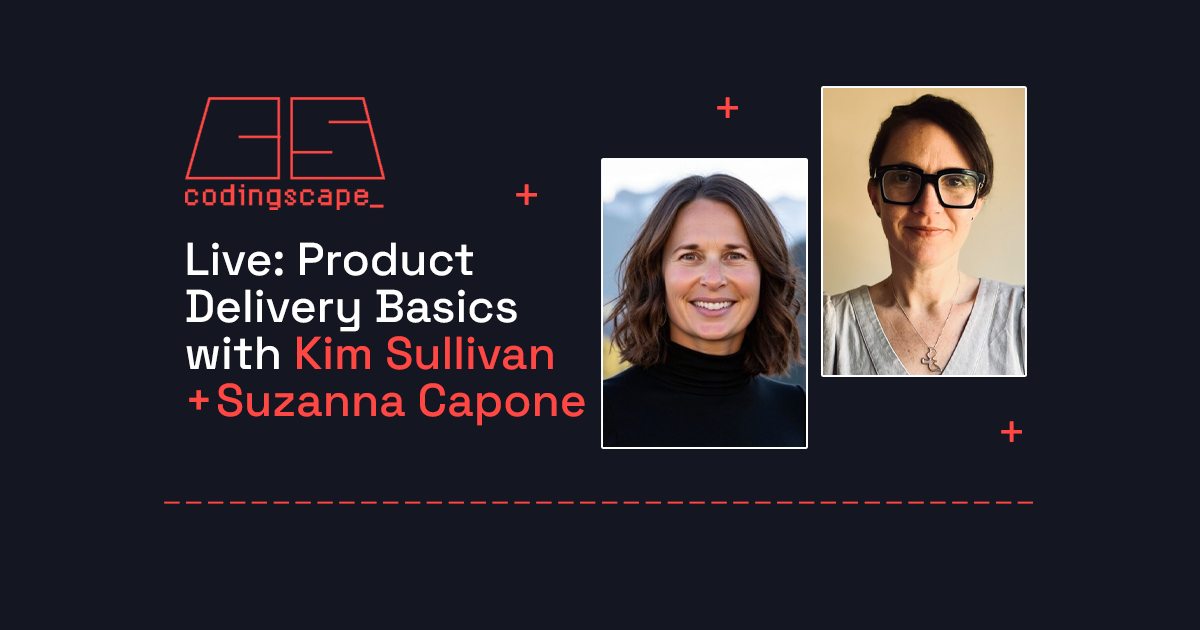Live talk: Basics for faster product delivery
Read Time 4 mins | Written by: Cole

The world of product delivery is ever-evolving, requiring leaders to stay curious, adaptable, and collaborative. Whether you’re building a product, optimizing workflows, or fostering cross-functional alignment, success hinges on the ability to combine strategic vision with tactical execution.
It’s also critical to know the difference between delivery roles – project, product, and program, are all interrelated but have big differences.
In this Codingscape live tech talk, host Lauren Mason Carris (Sr. Product Consultant) sits down with Kim Sullivan (Head of Product and Design) and Suzanna Capone (Director of Product Operations), to discuss product delivery, operations, leadership, and trends in today’s fast-moving tech world.
Watch video: Basics for faster product delivery
Or read through a quick summary of the conversation below.
Delivery differences between project, product, and programs
Kim and Susie broke down the distinctions between three key roles often found in tech organizations – project managers, product managers, and program managers.
While their responsibilities overlap at times, they each have unique focuses:
Project management
- Focus – Delivering a specific project on time, within scope, and on budget.
- Responsibilities
- Managing timelines and processes.
- Tracking risks and ensuring deliverables stay on schedule.
- Coordinating tasks across teams. - Typical tasks – Running agile practices like daily standups, sprint planning, and retrospectives.
- Key outcome – Ensure the how and when of delivery are clearly managed.
Product management
- Focus – Defining and building the right thing.
- Responsibilities
- Understanding customer needs and aligning them with business goals.
- Defining what features or products to prioritize and why.
- Collaborating closely with design and engineering teams. - Typical tasks – Creating roadmaps, conducting discovery sessions, and prioritizing feature development.
- Key outcome – Own the what and ensure it aligns with customer and business needs.
Program management
- Focus – Overseeing multiple related projects and teams to achieve a larger strategic goal.
- Responsibilities
- Coordinating across multiple projects and teams to ensure alignment.
- Managing risks and resources across a portfolio of projects.
- Facilitating communication and status reporting for leadership. - Typical task – Holding “scrum of scrums” meetings, ensuring cross-team dependencies are addressed, and providing a high-level view of overall progress.
- Key outcome – Maintain oversight of large-scale initiatives by tying individual project outcomes to broader organizational goals.
Key distinctions
- Project management ensures execution details are clear, focusing on scope and timelines.
- Product management drives the vision and strategy behind what gets built.
- Program management takes a macro view, ensuring multiple projects and teams are working cohesively towards shared goals.
Kim highlighted how these roles often blur in practice, especially in smaller teams or startups.
In many cases, program managers act like product operations leads, focusing on streamlining workflows, while project managers may adopt scrum master responsibilities.
Suzanna noted the importance of tailoring these roles to the organization’s needs, as titles and expectations can vary widely across industries.
Trends in product delivery
Collapsing Talent Stacks
Kim reflected on the shift towards multi-skilled product teams, driven by advancements in AI and no-code tools. These innovations empower product managers to:
- Create wireframes or prototypes without designers.
- Test and refine concepts independently, accelerating decision-making.
Understanding some key product terms
The conversation touched on several common product management terms:
- 1P vs. 3P
- 1P (First Party) – Building custom software in-house.
- 3P (Third Party) – Leveraging third-party tools. - PRD (Product Requirements Document)
-A written artifact aligning stakeholders on project scope.
-Kim prefers concise, actionable one-pagers over lengthy documents.
Data-driven product development
Suzanna cautioned against over-reliance on data alone:
- Quantitative metrics – Track tangible results like conversion rates or time to complete tasks.
- Qualitative insights – Capture user sentiment through surveys or interviews.
Balancing both perspectives ensures teams focus on solving real problems rather than chasing vanity metrics.
Advice for CEOs and technology leaders
When asked how founders can best support product teams, both leaders agreed:
- Start with the problem – Avoid dictating solutions—allow product managers to explore opportunities and validate ideas.
- Build well-rounded teams – Combine strategic thinkers, execution-focused team members, and those with consultative skill sets to foster healthy debate and collaboration.
- Stay open to change – Be willing to pivot based on new insights or shifting priorities.
When to hire full-time vs. fractional resources
Deciding between hiring a full-time product manager or using fractional support depends on several factors:
- Consider full-time
-When immediate availability and responsiveness are critical.
-For high-profile, fast-moving projects. - Consider fractional
-For maintenance projects with lower complexity.
-When budget constraints limit hiring.
Hire Codingscape to speed up your product delivery
Whether you need to speed up delivery on your roadmap or start a new mobile modernization project, Codingscape has the delivery experts you need.
We can assemble senior product teams that know your tech stack and start delivering results in 4-6 weeks.
Zappos, Twilio, and Veho are just a few companies that trust us to build their software.
You can schedule a time to talk with us here. No hassle, no expectations, just answers.
Don't Miss
Another Update
new content is published

Cole
Cole is Codingscape's Content Marketing Strategist & Copywriter.
